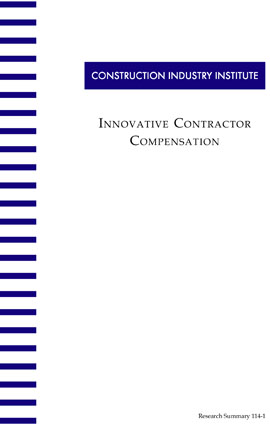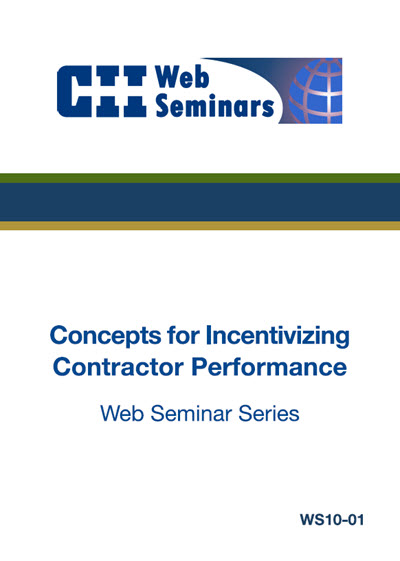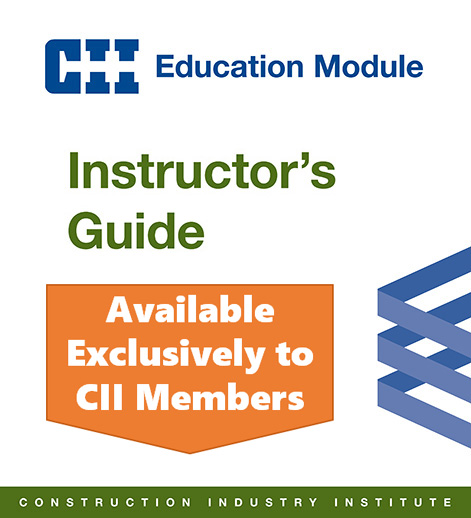
Innovative Contractor Compensation
The Contractor Compensation Research Team was established to develop breakthrough approaches to contractor compensation. Founded on the premise that traditional engineering and construction contracts perpetuate competing interests between owners and contractors, the team began with the goal to rethink contractor compensation in order to align contractor performance more closely with owner objectives. Compensation was interpreted broadly to include reward, recognition, money payment, future opportunities, expanded roles, and reduced risk.
The team found innovative contracting strategies that go well beyond traditional concepts of alliances, team autonomy, and incentive contracting. No single breakthrough strategy or set of metrics, however, was applicable to all projects.
The development of contractor compensation plans that lead to owner success is highly individualized to the specific project and the personalities and philosophies of project leaders that craft the contract. Timing of development of the contracting strategies, however, is not as important as establishing: (1) a trust-based relationship among project team members and (2) the willingness to develop the compensation plan jointly. These two factors are most important in establishing innovative compensation plans, but are often the largest barriers to success.
The application of innovative contractor compensation strategies should not be considered an “end all” solution to project performance improvement. Such strategies instead should be considered one more important tool in a project team’s “tool kit” to be applied in conjunction with other CII best practices such as partnering, team building, team alignment, open communications, setting project objectives, and pre-project planning.
Two factors are most important in establishing innovative compensation plans and are often the largest barriers to success. These factors are:
- A trust-based relationship among project team members
- The willingness to develop the compensation plan jointly
The 32 innovative contractor compensation strategies, developed through 14 case studies and a national workshop, were grouped into the following 10 categories. (RS114-1, p. 3)
- Development of Incentive Plans – Joint development of the incentive plan promotes sharing of information and leads to more efficient contracting relationships.
- Selection of Performance Measures – Performance areas selected for inclusion in an incentive plan should correlate to key results for the owner and must sufficiently span the contractor’s performance so that important aspects of performance are not neglected.
- Application of Performance Measures to Incentive Calculation – Incentives can be attached to both objective and subjective performance measures.
- Project Team Member Incentives – Incentives paid to individual team members often may be integral to contractor corporate incentive plans.
- Incentive Effect Improvement through Increased Contractor Control – Incentive effectiveness is directly proportional to the control that the contractor has over those areas covered by incentives. Therefore, the owner’s choice of project execution strategies is a critical ingredient to the overall effectiveness of an incentive plan.
- Maintenance of Incentive Targets in Long-Term Relationships – Long-term relationships, such as partnering arrangements or annual maintenance agreements, permit the use of some innovative contracting methods.
- Promoting Long-Term Contractor Focus on Owner Objectives – Traditionally, owner objectives are longer-term than those of the contractor. Some case studies revealed instances where owners, through innovative strategies, attempted to focus contractor’s interest for the longer term.
- Future Work as a Motivator – One long-term objective of contractors is to secure repeat work from clients. This objective can provide a useful basis for incentives.
- Alternative Compensation Units – Variations in cost-reimbursable units were found to be effective.
- Cash Flow Enhancements – Variable cash flow arrangements can be used as an incentive for contractor performance.
Projects employing innovative compensation strategies have realized substantial tangible and intangible benefits including: (RS114-1, p. 11)
- A 27% underrun relative to budget
- Three month early completion on a 24-month project
- A 4% improvement in plant production availability
- A 20% reduction in craft labor hours relative to budget
- A 22% reduction in overhead charges
- No lost-time accidents
- Best contractor resources allocated to the project
- Reduction in “defensive” paperwork
- Steadily improving contractor performance over a four-year period
The top five innovative compensation strategies identified are (RS114-1, p. 12):
- Incentives developed during project kickoff and teambuilding creates joint ownership.
- Benchmarking to set performance targets creates credible yet challenging targets.
- Incentives on joint performance of designer and contractor creates alignment with owners goals.
- Extensive preliminary engineering reduces risk to contractor and supports stronger incentive contracts.
- Future work as a motivator enables savings to be obtained in bidding strategy.
Concepts that should be considered by owners and contractors in crafting a compensation strategy include: (RS114-1, p. 20)
- Conflict between owner and contractor objectives is natural and should be addressed in development of compensation plans.
- Translation of owner business objectives to project objectives, and their communication to the project team, is not inherent in the capital project process.
- Establishing a trust-based relationship among project team members and the willingness to develop the compensation plan jointly are two important factors in establishing innovative compensation plans, but are often the largest barriers to success.
- Incentive plan contracts currently in use are based on objective performance criteria, subjective criteria, or a mix of the two.
- Incentives can have a positive effect on contractor’s performance, but the performance gain must be balanced against the costs of shifting related risk to the contractor.
- Targets should be adjusted if factors beyond the contractor’s control prevent achievement.
- Aggressive plans are perhaps best suited to parties that have worked together effectively for some length of time in an alliance or partnering relationship.
- Continuous evaluation of performance provides important feedback to the contractor.
- Owners are not often aware of the degree to which they constrain contractor performance by the way of work processes, team structure, and decision-making processes.
- More aggressive plans require more detailed design and better project monitoring.
Some degree of joint development of the compensation plan is preferred because a sense of joint ownership in the plan is created.



